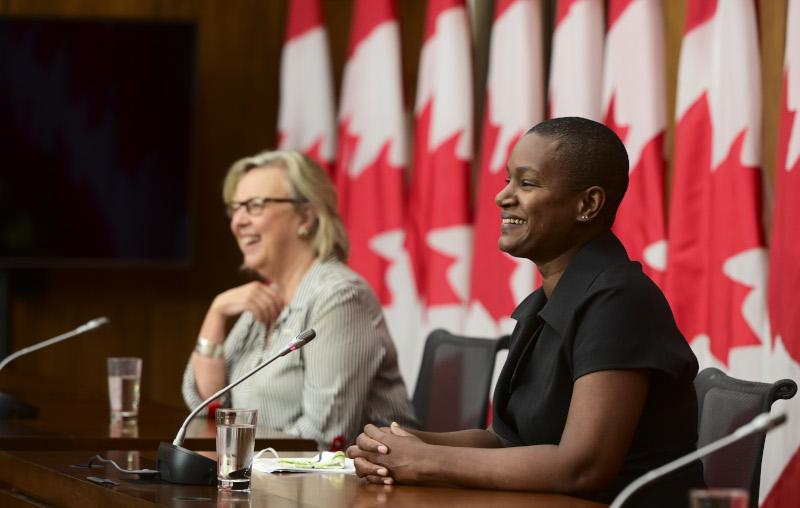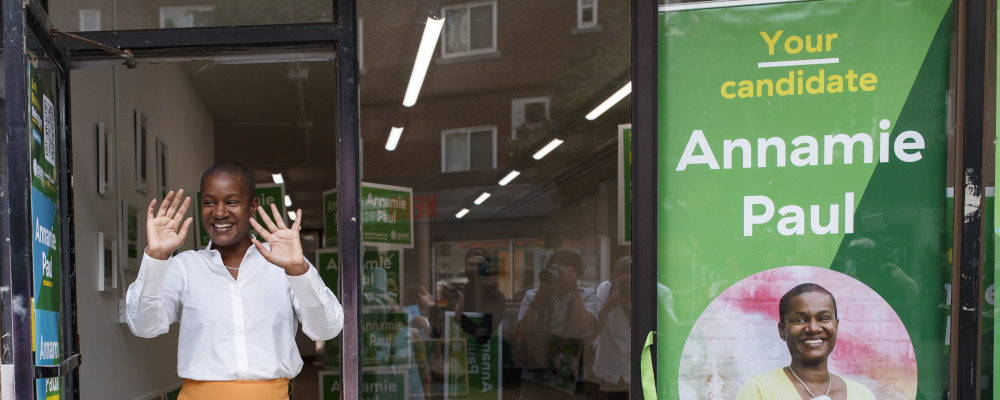With an election on the horizon, the Green Party is in the process of imploding. It has been a unique and interesting type of implosion, one rarely if ever seen in Canadian politics. Think not of a standard fire on the side of the road, but rather of a flaming fuel truck crashing into a mobile missile launcher then crashing into a fireworks store.
The most frequent response I’ve heard to all this has been both wonderment and a sense of incomprehensibility: “they did what?”
MORE SIGNAL. LESS NOISE. THE HUB NEWSLETTER.
The immediate cause of strife is, of all things, disagreement over the party’s response to conflict in the Middle East, and specifically the view that the party’s seat-less leader, Annamie Paul, and her small circle of advisors are out-of-step with the prevailing pro-Palestinian sentiment in the party, including in its tiny caucus.
In May, Paul advisor Noah Zatzman took to Facebook to accuse Green MPs (among others) of “appalling anti-Semitism and discrimination.” Zatzman promised to work to defeat his own MPs.
As it turns out, this raised a few eyebrows in the party. One would expect the leader to forcefully condemn such an attack on the party’s MPs, but instead Paul equivocated. Early June then saw Fredericton Green MP Jenica Atwin bolt to the Liberals. Paul and Atwin had already clashed over the Middle East, with Atwin harshly condemning a “totally inadequate statement” issued by Paul which tried to strike a balance between Israel and Palestine.
Amusingly, Atwin’s journey from ideological rump party to the Trudeau Big Tent meant the previously zealous campaigner for Palestinians (“I stand with Palestine… End Apartheid!”) had to strike a new balance of her own, sheepishly writing that “Palestinians are suffering. Israelis are also suffering…” But the more important point was that Paul had mishandled the intra-party conflict and as a result had lost a third of the Green caucus.
This is where things start to get a little zany. So before moving on, we need some tools to help understand conflict in the Green Party that, from a Canadian perspective, seems strange and exotic. Political scientists Richard Katz and Peter Mair, writing in 1993, argued that we should stop thinking about political parties as singular, unitary actors. Instead, we should view parties as multi-dimensional organizations with potentially many actors holding different and possibly conflicting interests and goals.
Katz and Mair provided a tool to understand parties as multi-dimensional. All parties, the argument goes, have three “faces”: the party in public office (the elected party caucus, the leader), the party in central office (the party bureaucracy including the party president that, for example, raises funds and maintains the membership), and the party on the ground (in Canada, the party constituency associations in each of the ridings). To understand how parties work, Katz and Mair argued, you have to figure out the relative powers of each of these faces, and how they relate to (and exercise power over) one another.
In Canada, we have long viewed our old parties as a kind of partnership between the party in public office and the party on the ground. According to this argument, powerful party leaders (the party in public office) hold the right to set policy and speak for the party but, in return, the constituency associations (the party on the ground) hold the right to nominate candidates. There are some exceptions and the two sides often push against one another, but this balance largely holds.
But we rarely hear about the comparably weak party in central office in Canadian politics. Don’t believe me? Without consulting Google, try to identify the president of the Liberal Party. The Conservatives? NDP? I have no idea who these people are.
This is because the norm in Canadian parties is for the leader, not unelected party officials, to speak for the party. And, where necessary, party leaders have effectively captured the party in central office. Indeed, one key reason Stephen Harper remained as leader of the Conservative Party as long as he did was because of his mastery of the party bureaucracy, particularly the Conservative Fund Canada. As Tom Flanagan argued of Harper’s time as leader, “The reality is that the leader controls the party through the Fund, especially its chairman, and through the national director of the party…”
But the predominant Canadian way of organizing parties — a strong party in public office and party on the ground but weak party in central office — is not how all parties are organized in other democracies. Many other parties have strong, autonomous party bureaucracies that speak for the party and which the elected leader must contend with. And it turns out that the Greens have a strong party in central office which is willing to assert itself against the party leader when necessary.
Try to imagine Justin Trudeau having his membership in the Liberal Party suddenly suspended during a fight with faceless party bureaucrats.
Using Katz and Mair’s tools, the remarkable conflict in the Green Party that followed Atwin’s defection starts to make some sense. Following Paul’s failure to condemn Zatzman, the Greens’ Federal Council threatened to hold a vote of non-confidence on Paul’s leadership if she didn’t repudiate her advisor and pledge support to the party’s caucus.
At some point, an arbitrator was recruited to mediate the conflict between Paul and the Federal Council which resulted in the leadership vote being delayed. However, the Federal Council is now in court arguing that the arbitrator’s orders should be quashed.
And it turns out the party in central office has other significant powers over the Green leader. When Paul refused to fire Zatzman, the party did an end run around the leader by simply refusing to renew his contract, ending his employment in the party. The party’s executive director followed up by laying off roughly half the party’s paid staff, many of whom arrived in the party under Paul’s leadership. Paul’s ability to mount a national campaign was severely undercut by her party.

More humiliation was coming for Paul as the party in central office flexed its authority. Party brass declined to provide funding for Paul’s constituency campaign in Toronto Centre, which will make it difficult for Paul to defeat the Liberal incumbent in that seat. Remarkably, the Federal Council also discussed revoking Paul’s membership in the Green Party. If the council succeeds, the Greens would be in the interesting position of having a non-member as leader of their party.
Try to imagine Justin Trudeau having his membership in the Liberal Party suddenly suspended during a fight with faceless party bureaucrats. Then try Erin O’Toole. It’s almost unimaginable. This reflects the ways their parties are organized, in which the party bureaucracy is effectively weak. But the Greens have built a different type of organization, and so the challenges facing Paul are quite different.
Opinion-makers in Canada often give voice to a paradox: they complain incessantly about the lack of internal democracy and debate in Canadian parties, noting correctly that Canada’s parties are needlessly, gratuitously disciplined; indeed, our parties are among the most disciplined in the democratic world.
The sense is that Canadian democracy is not well served by excessively limiting debate and disagreement. But when there is conflict or when party actors dare not to sing from the leader’s songbook, these same opinion-makers condemn the party for appearing shambolic, which could make it difficult to win future elections.
Needless to say, these opinion-makers do not have much good to say about the fractious Green Party these days. But I think there is something comforting about watching the Greens do battle with one another. Most of us get involved in politics because we believe something and want to fight for it.
The Greens remind us that some things in politics are worth fighting — and fighting hard — for, and that these things should not always be subjugated to the electoral needs of a party. Atwin’s defection is instructive here: by bolting, she may well have switched from the losers to the winners. But the steep price she paid for doing so was abandoning her previously categorical and passionately held principles related to the rights of Palestinians.
The Greens might well be heading for electoral oblivion, but I’ll bet they sleep well at night. In contrast, I wonder: how well does Atwin sleep?




